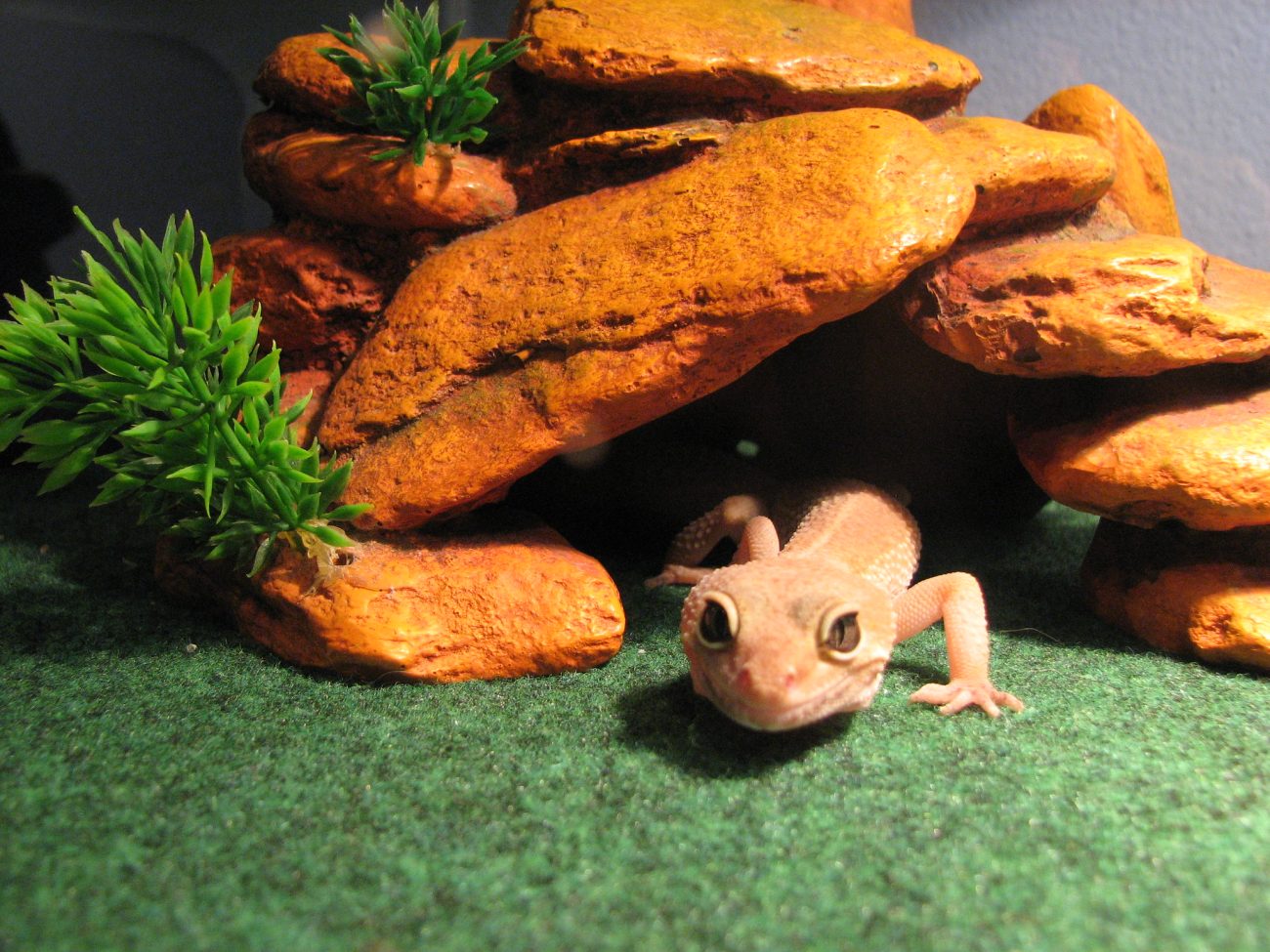We all need a place to hide from the outside world from time to time. Or, if you are a leopard gecko, pretty much all the time.
Hides are critical for reptile health and quality of life and are especially important for ground lizards. They help leos regulate their body temperature and humidity, reduce stress, and express natural behaviors.
Although providing hides is a no-brainer, many questions remain. How many hides do you need in your tank? How best to position them? What type of reptile cave should you choose (from so many)?
Continue reading for answers!
Here are some of the best commercial leopard gecko hideouts in 2024.
1. Zoo Med Reptile Shelter 3 in 1 Cave, Medium
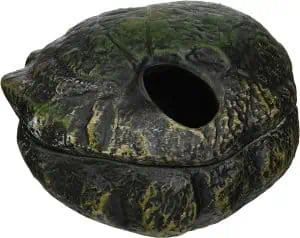 This cave by Zoo Med is already a classic. The idea is simple but ingenious – the enclosed hide has only one small entrance at the top and a removable lid for easy access to the inside. It makes the cave extra-cozy but still easy to manipulate and maintain.
This cave by Zoo Med is already a classic. The idea is simple but ingenious – the enclosed hide has only one small entrance at the top and a removable lid for easy access to the inside. It makes the cave extra-cozy but still easy to manipulate and maintain.
Pros
- The cave has a lid, meaning you have easy access to the inside.
- Available in two sizes – 10’’ x 8’’ x 6’’ and 5’’ x 4’’ x 3’’ (the smaller one is ideal for babies and juveniles, but it is too small for adults).
- Retains a lot of moisture and works as a hide and as a nesting box.
- The removable lid makes it easy to check on your animal or remove eggs.
- The resin used is really durable.
- Now available in eco-friendly ceramic version.
Cons
- Artificial material (resin).
- The color, although (relatively) naturalistic and well done in general, doesn’t really match an arid naturalistic habitat.
- Customers sometimes complain about the durability and less realistic look of the ceramic eco-friendly version.
🦎 Find the Zoo Med Reptile Shelter 3 in 1 Cave, Medium on Amazon
2. REPTI ZOO Gecko Hide Cave, 2 in 1
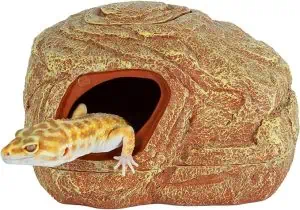
Pros
- Pretty similar to the Zoo Med’s version, except that it has special plugs for the holes; that way, you can create a hide that is more closed or more open, depending on your needs.
- Works as a hide and as a nesting box.
- The bottom can be detached and used as a feeding tray, while the lid continues to function as a classic cave.
- The resin used is durable.
Cons
- Artificial (plastic) material.
- It may be too small for extra-large adult leos – check the dimensions.
🦎 Find the REPTI ZOO Gecko Hide Cave, 2 in 1 on Amazon
3. REPTIZOO Reptile Resin Hide With Water Basin
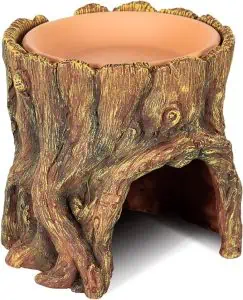
Pros
- An extra helpful hide if you’re struggling with low humidity levels in the tank and/or difficult shedding.
- The manufacturer guarantees that the used materials are safe, non-toxic, and easy to clean.
- The tray provides an additional water source for the gecko.
- The design is thoughtful and practical – the terracotta dish is easily removed for cleaning, and the cave is spacious enough.
Cons
- The “stump” doesn’t look as naturalistic as the producer says
- If the hide’s terracotta dish is not the only water dish in the tank, check the humidity levels occasionally. Too many open water sources can cause the humidity in the tank to go above the desired levels.
- Artificial main material.
🦎 Find the REPTIZOO Reptile Hide Cave on Amazon
4. Niteangel 2 Pack Natural Coconut Reptile Hideout
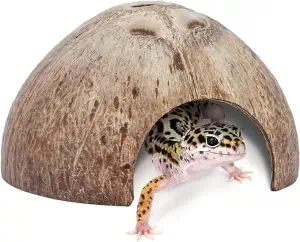
Pros
- Completely natural and durable material
- The round shape makes the cave comfy for your reptile
- Sustainable production with Amazon’s ClimatePledgeFrienldy badge (essentially, coconut shells are a waste by-product)
- Easy to fit in where more bulky, resin caves wouldn’t really work
Cons
- A smoothed surface may make it difficult for your leo to climb on the top; leaving the shell rough would be better in that respect.
- The coconut cave is so simple that you could essentially make one yourself, with no need for expenses and shipping.
- They may not work for larger leo individuals.
🦎 Find the Niteangel 2-Pack Natural Coconut Reptile Hideouts on Amazon
5. Small World Slate and Stone Store’s Natural Slate Stones – Large, 5 to 7 Inches
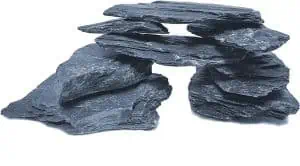
Pros
- Fully natural material.
- Highly decorative due to its specific surface and dark color.
- It lets you customize your leo enclosure and make it unique and naturalistic.
- Slate provides a good grip for climbing, so your lizards can use the upper surface of the shelter as well.
- By buying these stones, you’re supporting a small, family-run US business.
Cons
- Making caves from slate, especially of this size, can take some time and effort.
- Going to your local home and garden supplier (hardware store, garden center, etc.) may pay off more, plus it allows you to hand-pick particular pieces yourself.
🦎 Find the Small World Slate and Stone Store’s Natural Slate Stones on Amazon
6. Mopani Natural Driftwood for Aquarium Decor, 7-11 Inch
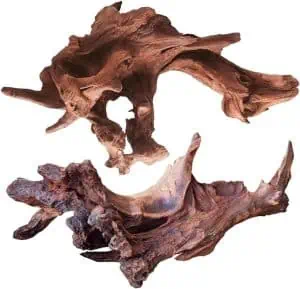
I would recommend driftwood as an ornament with a hide function, not as the primary cave (but if your leo prefers it, too, it’s perfectly fine).
Pros
- Natural material and natural look
- Interesting driftwood shapes add extra aesthetic points to your tank
- Can provide an additional climbing opportunity
Cons
- Not suitable as a moist hide.
- Each driftwood is unique; with web shopping, you don’t get to choose the exact piece of wood. Thus, you’ll need some luck to obtain just what you need. In some cases, some pieces of wood you get won’t work as a gecko hide (which doesn’t mean it can’t be used otherwise). Buying decorative wood in person at a pet store may be a better option.
🦎 Find the WDEFUN Natural Driftwood for Aquarium Decor on Amazon
7. EZ Botanicals Cork Bark – 1lb (Assorted)
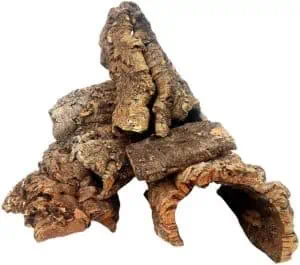
Pros
- Hiding-friendly natural shape
- Geckos will use the upper surface for moving around
- Versatile
- Sustainably sourced
Cons
- It might be tricky to disinfect with regular disinfectants in case of parasites or mites (although you can always bake!)
- It doesn’t make the best moist hide or the egg-laying cave.
🦎 Find the EZ Botanicals Cork Bark on Amazon
Tips for Buying a Leopard Gecko Hide
Considering material and durability
Reptile hides are made of two types of materials: natural materials (mostly rock and wood) and artificial materials (mostly durable plastic resin). Both have their own pros and cons.
Natural hides
Natural hides include rocks, wood, branches, and other plant materials, such as coconut husks. Also, hides created from Excavator Clay and similar products count as natural.
I’ll be frank here – I always give an advantage to natural materials. Although resin is known to be very inert and safe, you can’t never be fully confident with plastic polymers, especially when they’re exposed to heat. Remember that plastic’s reputation went from perfectly safe and solid to the microplastic and chemical leachate madness we know about today.
Another plus on the side of natural material hides is that leopard geckos are small, lightweight, and don’t get rowdy like larger lizards (beardies, iguanas, etc). So, the stability of artificial, heavy-resing caves is not as crucial for leos since they don’t knock over their hides anyhow.
Artificial hides
Most commercial hides are made from durable plastic/epoxy resin.
Artificial materials have one big advantage – resin can be shaped in any way the manufacturer wants it. This gives us very practical designs that would be hard or impossible to replicate with natural materials. Corner caves or rounded hides with removable lids are good examples of very handy designs that sometimes work better than the original.
Also, artificial caves and hides tend to be easy to disinfect with all the recommended reptile disinfectants and won’t soak in the chemicals.
On the downside, even the hides advertised as “naturalistic” and “natural-looking” will still look a bit fake at best and like cheap plastic toys at worst. There is simply no way to replicate the look of natural surfaces in plastic completely.
Now, about plastic safety. The epoxy resin is considered inert and safe for everyday use once it is ‘cured’ (hard and settled). However, few all-encompassing studies have been done on it. Some studies of epoxy-lined water pipes show that they can leach BPA and other compounds into the water.
Still, of all the types of plastic, epoxy resin is probably among the safest.
DIY hide ideas
Some DIY lovers will want to create hides themselves. There are several options.
https://www.youtube.com/watch?v=47zqBGLjWqc&ab_channel=LeopardGecko
- Clay. You can make nearly anything out of clay, and the look and feel are quite natural. You don’t even have to bake your goodies – the clay can be simply air-dried, although this reduces the durability and doesn’t make objects water-resistant. However, in the case of leos, that doesn’t matter too much.
- Excavator clay is also an option for building an entire enclosure, including the hides. Arm yourself with patience, as can be a bit difficult to work with.
- Slate. I already mentioned making custom naturalistic hides from slate. There are plenty of tutorials online to give you ideas.
- Coconut shells. Besides buying them, you can make coconut shell hides yourself. Sometimes, the shell will break in a way that doesn’t require any power tool use. If it breaks evenly in half, you’ll have to find a way to break or cut an entry into the coco cave.
- Simple upcycled plastic dish moist hide. Although this is an unsightly option and it includes unnatural materials, it can be an excellent solution as a temporary moist hide or a nesting/egg-laying box.
- 3D printed hides. For more ambitious makers out there, you can create your perfect hide with 3D printing. ‘Underground caves’ are an especially attractive idea in this category. Still, it’s plastic – not fantastic.
Considerations for choosing the right hide
1. Size
Leopard geckos and other reptiles like to get all snuggly in their hides, meaning that the hide shouldn’t be too large. They should fit right in, but tightly. That means that you may have to change your hides as your leo grows.
2. Material
We’ve discussed materials at length above, but to sum it up – natural materials will always have an advantage in my book. However, there are situations where commercial epoxy resin hides are certainly more practical – and the resin used by reputable producers is usually as safe as plastics can be.
For moist hide, you’ll also have to use a special absorbent substrate – eco earth/coconut coir or sphagnum moss work best, in my experience.
3. Accessibility
Leopard geckos are ground lizards, so it is important that all their hides rest on the ground. Above-ground hides and structures like hammocks are simply not suited for leos.
Also, make sure all surfaces around the hides are stable (or stabilized) and not wobbly. The area around the hide’s entrance doesn’t need to be flat and clear, but leo should have a firm grip when accessing them.
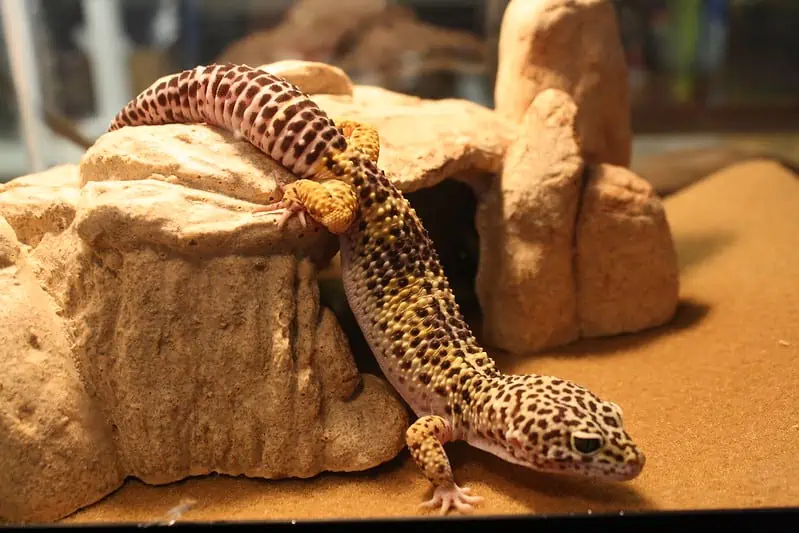
Why Does Your Leopard Gecko Need a Hide?
The well-thought-out hides are especially important for ground-dwelling lizards like leopard geckos. They are burrowing creatures and naturally tend (and need) to hide a lot, especially during the midday.
Plentiful hides allow them to both express their natural behavior and reduce everyday stress. If your gecko goes into brumation every autumn and winter, comfortable hides are essential for their well-being during the resting period.
Moist hides have additional benefits because they help leopard geckos maintain proper humidity and shed without issues. While leos naturally live in arid environments, their largely burrowing, secretive lifestyle allows them to fine-tune the humidity of their immediate surroundings by finding cooler, moister spots in otherwise dry habitats. Moist hides should always be more enclosed to keep sufficient moisture and, of course, have an absorbent substrate at the bottom (eco earth or sphagnum moss).
Humidity provided by moist hide is critical during shedding. The truth is simple: if you keep your geckos in a completely dry environment with no moist hides, they will most definitely have difficulty shedding at some point in their lives, plus other skin-related issues.
How Many Hides Should Leopard Geckos Have?
In general, leopard geckos should have at least one moist and one dry hide. So, two hides are a bare minimum – but we can do better than that.
Three hides are also a better option – one on the warm side of the tank, one on the cool side of the tank, and one in the middle of the temperature gradient. In my opinion, the middle one is ideal as a moist hide. However, if you can do more, having one moist and one regular hide in the warm part of the tank is ideal.
Of course, you can make as many hides as you’d like. They don’t all have to be heavy-duty and lavish – simple hides from natural bark or coconut shells also count!
Personally, I like structures that can serve as hides, climbing/activity surfaces, and decoration – all in one. This approach allows you to create numerous hides that don’t essentially look like caves and are quite natural. It is easier to make such setups by combining natural materials – but it takes some time and effort to get it right and source the ideal pieces for the setup.
Another interesting twist from my personal practice is what I call a ‘versatile hide’ – the hide can be moist or dry, depending on the occasion. It is more open than a moist “hide-box” type, but the substrate needs to be absorbent (soil mix would do fine).
For example, in one of my tanks, there is a weirdly shaped river rock with an indentation at the base. It is on the warm side of the tank. If one of my geckos happens to hang around there before shedding, I turn it into a moist semi-moist hide with a few sprays of water. Otherwise, I keep it dry.
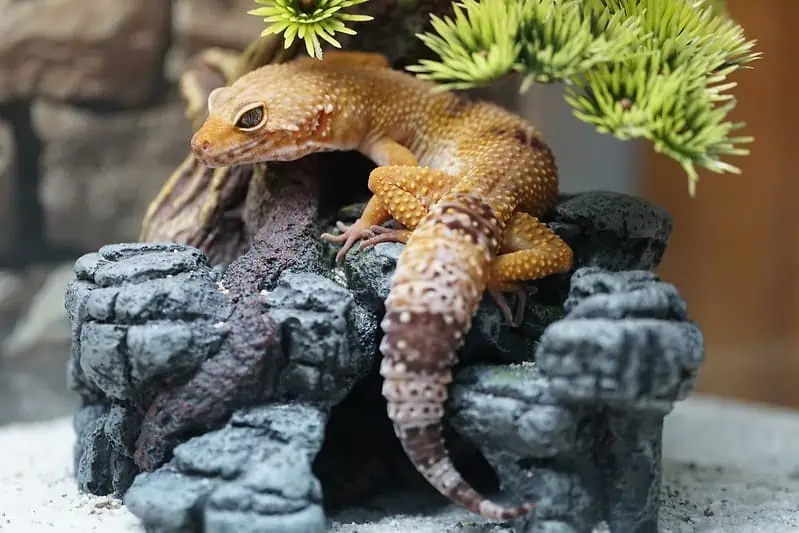
Do Leopard Geckos Hide When They Shed?
It is true that leopard geckos have a natural instinct to hide during shedding.
Unlike other lizards whose old skin falls off in pieces while they go about their day, leopard geckos shed their entire skin in one sitting – and they have to eat it, too.
Because geckos are naturally vulnerable during the shedding process (think about it: they have to slow down, get preoccupied with getting the shed off, and then take some time to chow it down), they’ll always take cover during the shedding process. Also, they will likely stay in their hideout for some time afterward to rest.
In nearly all cases, leos will instinctively pick the moist hide because the moisture helps to get the shedding skin off entirely. That is especially important for tricky areas like fingers.
Conclusion
To summarize, hides and caves are essential pieces of a leopard gecko enclosure and are among the most important structures you’ll create in the tank.
Take time planning them out and adjusting them on the way. The effort will be rewarded by the good mood and health of your leos and the spectacular terrarium looks.
I hope you’re happy with how I revealed the best leopard gecko hides out there (revealing – hides – get it?) and that now you have a better picture of what makes a good ‘reptile cave.’ If you have any remaining questions, let us know in the comments – I’ll gladly reply!
Featured Image Credit – Sam

